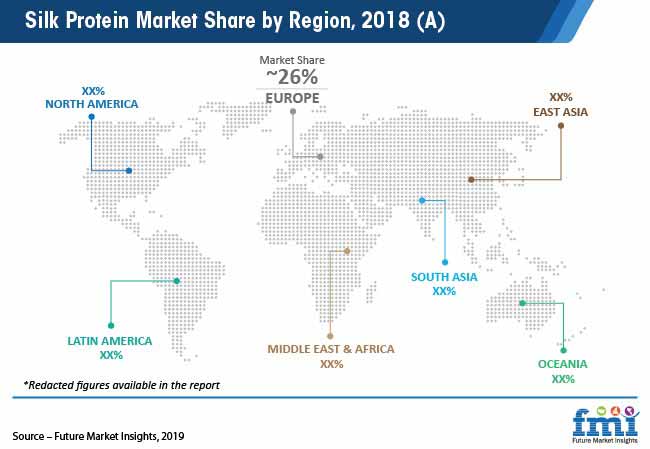According to a new study by Future Market Insights, the sale of silk protein is expected to reach ~ US$ 950 Mn in 2019. The rise in the demand for silk protein is due to various factors such as growing inclination towards personal grooming and increasing usage of natural ingredients in skincare products. Silk protein, due to the immense skin benefits, continues to find increasing application in skincare industry, while manufacturers are focusing on identifying and leveraging white spaces in its application, especially in eye care and toiletries.

Silk protein is a natural product made by silkworm. It consists of two proteins- fibroin and sericin; the sticky nature of sericin makes it easier to be used in numerous applications. According to FMI’s analysis, the emergence of green and clean beauty trends among today’s consumers have brought significant changes in the cosmetics and personal care industry, including a notable rise in the use of natural ingredients. The result is likely to lead to surge in the demand for silk protein.
The silk protein market is mainly segmented on the basis of form, product and applications:
Form: The powder form of silk protein continues to garner relatively high traction as compared to its oil, on the account of convenience and ease of storage and transportation. However, in recent years, the silk protein oil has been finding numerous application in haircare and skincare products, which may help exceed the sales of its powdered counterparts in the years ahead.
Product: Silk protein consists of – sericin and fibroin. Although fibroin continue to account for higher sales, manufacturers are focusing on increasing the production of sericin for its sticky nature and numerous beneficial effects, which will help them capitalize on ever-rising demand for natural ingredients in cosmetics & personal care products.
Application: Silk protein finds increasing application in skincare, haircare, eye care, toiletry, lip care, color cosmetics, and pharma & nutraceutical products. The consumption of silk protein by the pharma & nutraceutical industry is expected to grow with a CAGR of ~9% during the forecasted period. The demand for natural products in the nutraceutical industry is growing tremendously, owing to its reduced side-effects, thereby potentially raising the demand for silk protein.
Request a report sample to gain comprehensive market insights @
https://www.futuremarketinsights.com/reports/sample/rep-gb-7299
Bioengineered Silk Proteins to Control Cell and Tissue Function
The fibrous part of silk protein is used as a biomedical material, over which cell and tissue formation are been done. The cells which are not able to proliferate on their own, are proliferated in labs with the use of fibrous proteins, where cell adhesion, proliferation, and differentiation can be performed. Silk protein also supports the regeneration of tissues. This application of silk protein is very niche and is still in its R&D phase, but is showing positive signs. These above mentioned factors support the use of silk proteins in the healthcare sector, and can be included to treat patients suffering from cell division problems.
For Information On The Research Approach Used In The Report, Ask Analyst @ https://www.futuremarketinsights.com/ask-question/rep-gb-7299
Application of Silk Protein in Hair Care Industry to Propel the Market Growth
The most trending fashion in today’s era is permanent smoothening or straightening of hair, and is made possible with the help of sericin a protein present in the silk. It helps to change the inherited pattern of hair to smoothen and straighten. Silk protein is used as an ingredient in shampoo and conditioner to provide silky, smooth hair. It is also associated with increasing the volume of hair and preventing its breakage. Realizing the benefits, a number of haircare product manufacturers are adding silk proteins in their products to ensure smooth and damage-free hair for the consumers. Further, the U.V. protectant property of sericin helps protect hair against the damage from U.V. rays and its antibacterial and antimicrobial properties help the scalp to remain free from dandruff.
This study by FMI offers insights into the silk protein market for the forecast period of 2019-2029. The silk protein market is projected to record a CAGR of ~ 6% over the predefined timeframe. The silk protein market sales will increase owing to its wide applications in skin and hair care industry.